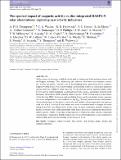The spectral impact of magnetic activity on disk-integrated HARPS-N solar observations : exploring new activity indicators
Abstract
Stellar activity is the major roadblock on the path to finding true Earth-analogue planets with the Doppler technique. Thus, identifying new indicators that better trace magnetic activity (i.e. faculae and spots) is crucial to aid in disentangling these signals from that of a planet's Doppler wobble. In this work, we investigate activity related features as seen in disk-integrated spectra from the HARPS-N solar telescope. We divide high-activity spectral echelle orders by low-activity master templates (as defined using both log R'HK and images from the Solar Dynamics Observatory, SDO), creating "relative spectra". With resolved images of the surface of the Sun (via SDO), the faculae and spot filling factors can be calculated, giving a measure of activity independent of, and in addition to, log R'HK. We find pseudo-emission (and pseudo-absorption) features in the relative spectra that are similar to those reported in our previous work on alpha Cen B. In alpha Cen B, the features are shown to correlate better to changes in faculae filling factor than spot filling factor. In this work we more confidently identify changes in faculae coverage of the visible hemisphere of the Sun as the source of features produced in the relative spectra. Finally, we produce trailed spectra to observe the RV component of the features, which show that the features move in a redward direction as one would expect when tracking active regions rotating on the surface of a star.
Citation
Thompson , A P G , Watson , C A , Haywood , R D , Costes , J C , de Mooij , E , Cameron , A C , Dumusque , X , Phillips , D F , Saar , S H , Mortier , A , Milbourne , T W , Aigrain , S , Cegla , H M , Charbonneau , D , Cosentino , R , Ghedina , A , Latham , D W , López-Morales , M , Micela , G , Molinari , E , Poretti , E , Sozzetti , A , Thompson , S & Walsworth , R 2020 , ' The spectral impact of magnetic activity on disk-integrated HARPS-N solar observations : exploring new activity indicators ' , Monthly Notices of the Royal Astronomical Society , vol. 494 , no. 3 , pp. 4279–4290 . https://doi.org/10.1093/mnras/staa1010
Publication
Monthly Notices of the Royal Astronomical Society
Status
Peer reviewed
ISSN
0035-8711Type
Journal article
Description
Funding: UK Science and Technology Facilities Council (STFC) consolidated grant number ST/R000824/1 (ACC).Collections
Items in the St Andrews Research Repository are protected by copyright, with all rights reserved, unless otherwise indicated.

